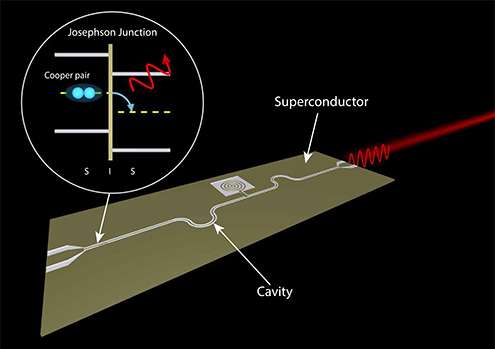Lasers are omnipresent. Quantum scientists use them to control qubits in quantum computers; doctors use them to correct eyesight; and cashiers scan your groceries with them. Current lasers are massive and inefficient. Quantum scientists work at severely low temperatures on rather small scales and, for over 40 years, have been looking for an accurate and efficient microwave laser to suit the cold environment.

But now, Leo Kouwenhoven and a team at Delft University of Technology unveiled an on-chip microwave laser based on superconductivity. To make this possible, they installed a tiny section of an uninterrupted superconductor, a Josephson junction (JJ) — consisting of two superconductors coupled by a weak link — in an engineered on-chip cavity.
Dutch physicist Heike Kamerlingh Onnes identified that materials transition to a superconducting state at extremely low temperatures, letting electrical current flow without losing any energy. The Josephson effect is a critical application of superconductivity, because if a short barrier interrupts a piece of superconductor, electrical exporters run through a non-superconducting material through quantum laws. The frequency they run through can be varied by an externally applied dc voltage, making it an ideal perfect voltage-to-light converter.
Lasers can emit perfectly corresponding light, meaning that the linewidth is very narrow. The introduction of the new on-chip microwave laser allows for applications in which microwave radiation with little dissipation is crucial. Typically, lasers are made from a significant number of atoms, molecules, or semiconducting carriers inside the cavity. The layers are often not efficient and deplete a significant amount of heat when lasing, making it hard to operate in low-temperature environments.
To create the Josephson junction laser, the scientists connected a Josephson junction to a superconducting micro-cavity — so minuscule, no larger than an ant. Similar to a single atom, the Josephson junction corresponds with the cavity-like two mirrors for microwave light. After a small dc voltage is applied, the junction emits microwave photons on vibration with the frequency of the cavity. The photons alternate back and forth between two superconducting mirrors and force the Josephson junction to release more photons coordinating with the photons in the cavity.
When the scientists cooled the device down to very low temperatures and applied a small dc voltage to the Josephson junction, they noticed an array of microwave photons emitted at the output of the cavity. Because the on-chip laser is created entirely from superconductors, it is extremely energy efficient and much more stable than prior lasers. The device uses less than a picoWatt of power to operate, a figure more than 100 billion times less than a light globe.
Current microwave sources are costly and ineffective; the Josephson laser, on the other hand, is energy efficient and provides an on-chip solution that is simple to modify and control. Looking to the future, this new on-chip microwave laser could produce amplitude-squeezed light that has smaller intensity variances compared to traditional lasers, which is crucial in many quantum communication customs.
Via Phys.org
Advertisement
Learn more about Electronic Products Magazine





